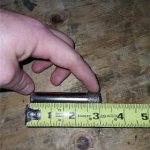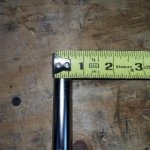Here’s one of some unusual grinding bits we found. Length 3”, solid shank dia. 5/8”. The stone looks like some we have that are supposed to be diamond-impregnated. What would be a typical use for these? I thought maybe jig grinder but I don’t know if jig grinder chucks hold anything that big, typical jig grinder stones I’ve seen had 1/4’ shanks. So, what rpm limit, what application?
How to install the app on iOS
Follow along with the video below to see how to install our site as a web app on your home screen.
Note: This feature may not be available in some browsers.
You are using an out of date browser. It may not display this or other websites correctly.
You should upgrade or use an alternative browser.
You should upgrade or use an alternative browser.
Need info on these monster grinding bits
- Thread starter Cannonmn
- Start date
- Replies 18
- Views 2,121
ADFToolmaker
Cast Iron
- Joined
- Mar 12, 2012
- Location
- Hamilton, New Zealand
These look like pins for ID grinding on a cylindrical grinder. They would fit my my machine. Could be jig grinders out there too that they would fit. More likely to be cbn rather than diamond.
CarbideBob
Diamond
- Joined
- Jan 14, 2007
- Location
- Flushing/Flint, Michigan
Common plated pin.
Any markings to tell if it diamond or cbn?
Any markings to tell if it diamond or cbn?
stephen thomas
Diamond
- Joined
- Jun 3, 2001
If grit is as coarse as 1st photo makes it look on my screen, could be for countertops or other type rocks?
smt
smt
eKretz
Diamond; Mod Squad
- Joined
- Mar 27, 2005
- Location
- Northwest Indiana, USA
Nobody's going to be able to tell you much of anything without some identifying markings. Without those all we can do is guess.
Thanks, I haven’t found any markings so how can I determine the basic composition of the abrasive by appearance or testing?
I’d compare the appearance of mine to other thick-shank pins on the web, particularly any 5/8 in. Shank, but I haven found any for sale. I’d like to do that because I’m pretty sure there are a very small number of manufacturers making 5/8 in. Shank bits, and maybe their heads will,have a distinctive appearance. One thing about those I have is that the head is coarse-looking as opposed to the super-smooth examples I see on the web.
I’d compare the appearance of mine to other thick-shank pins on the web, particularly any 5/8 in. Shank, but I haven found any for sale. I’d like to do that because I’m pretty sure there are a very small number of manufacturers making 5/8 in. Shank bits, and maybe their heads will,have a distinctive appearance. One thing about those I have is that the head is coarse-looking as opposed to the super-smooth examples I see on the web.
Last edited:
Here’s a better image where u can see the roughness, variegated coloration. I use this link so the image won’t be reduced by pm software. There are large grains of something visible.
Flickr: Page Not Found
Flickr: Page Not Found
Last edited:
Milland
Diamond
- Joined
- Jul 6, 2006
- Location
- Hillsboro, New Hampshire
They might be bespoke composite router bits. Things like fiberglass and the like.
If you look at the grit under a microscope, you "might" see some evidence of translucency if it's diamond, opaque (I believe) if CBN. This can vary depending on how the grit was treated prior to brazing, if metalized nothing might show until the free side metal was worn off.
But I'd bet they're diamond over CBN. Just a guess...
[This reference seems to state that CBN is transparent, but that may be just for thin homogeneous films, not grains for grinding purposes: "Because c-BN is transparent within the wider wavelength, another usage of c-BN will be in a protective coating for optical elements, particularly optical windows, for example, of ZnSe and ZnS."
Cubic Boron Nitride - an overview | ScienceDirect Topics ]
If you look at the grit under a microscope, you "might" see some evidence of translucency if it's diamond, opaque (I believe) if CBN. This can vary depending on how the grit was treated prior to brazing, if metalized nothing might show until the free side metal was worn off.
But I'd bet they're diamond over CBN. Just a guess...
[This reference seems to state that CBN is transparent, but that may be just for thin homogeneous films, not grains for grinding purposes: "Because c-BN is transparent within the wider wavelength, another usage of c-BN will be in a protective coating for optical elements, particularly optical windows, for example, of ZnSe and ZnS."
Cubic Boron Nitride - an overview | ScienceDirect Topics ]
eKretz
Diamond; Mod Squad
- Joined
- Mar 27, 2005
- Location
- Northwest Indiana, USA
They could even be tungsten carbide. About the only way you could do even basic testing yourself would be to see what one can cut and how fast it wears out. Try one on a carbide insert and see if it cuts. If not then it's probably tungsten carbide grit. If it cuts decent at first but dulls and slows down pretty quick it's probably CBN. If it's cuts really good and keeps cutting it's likely diamond.
Being that coarse I'd bet they're routing bits also. Probably for composites like G10 etc. I'm thinking they're electroplated, not furnace brazed.
Being that coarse I'd bet they're routing bits also. Probably for composites like G10 etc. I'm thinking they're electroplated, not furnace brazed.
eKretz
Diamond; Mod Squad
- Joined
- Mar 27, 2005
- Location
- Northwest Indiana, USA
You probably won't be able to spin it fast enough to reach optimal speeds, just spin it as fast as whatever you have available that can hold it.
Milland
Diamond
- Joined
- Jul 6, 2006
- Location
- Hillsboro, New Hampshire
We could do 150k rpm on the Moore jig grinder but unfortunately it isn’t hooked up now so we’ll have to settle for die-grinder speeds, maybe 30k rpm no-load, and make an adapter to hold the 5/8 diameter shank.
Umm, having tossed a long bit when over-enthusiastically using it in a router, I'd discourage you from trying to make an adapter to hold a heavy bit well outside the collet of a 30K machine. Router collets are usually pretty weak for their RPM (unless a quality 1/2" or so), and there's a lot of energy present if the bit/adapter goes flying.
If you do try it anyway, clamp the router behind a steel blast plate, and remotely plug in an extension to keep yourself out of the firing line.
And film it...
Umm, having tossed a long bit when over-enthusiastically using it in a router, I'd discourage you from trying to make an adapter to hold a heavy bit well outside the collet of a 30K machine. Router collets are usually pretty weak for their RPM (unless a quality 1/2" or so), and there's a lot of energy present if the bit/adapter goes flying.
If you do try it anyway, clamp the router behind a steel blast plate, and remotely plug in an extension to keep yourself out of the firing line.
And film it...
Good to know, so I’ll settle for whatever the BP will do, think 3800?, since we could put it in a 5/8” R8 and have few worries.
Milland
Diamond
- Joined
- Jul 6, 2006
- Location
- Hillsboro, New Hampshire
Good to know, so I’ll settle for whatever the BP will do, think 3800?, since we could put it in a 5/8” R8 and have few worries.
That'll work. Use a good vac with a HEPA filter to collect the dust, you don't want to breathe it or get it on the mill ways.
That'll work. Use a good vac with a HEPA filter to collect the dust, you don't want to breathe it or get it on the mill ways.
Good suggestions. We’ll use a BP that’s not our best one, where we do messy work.
eKretz
Diamond; Mod Squad
- Joined
- Mar 27, 2005
- Location
- Northwest Indiana, USA
With the 'D' probably a diamond grit router bit for composites like fiberglass or similar.
Similar threads
- Replies
- 21
- Views
- 2K
- Replies
- 27
- Views
- 3K
- Replies
- 5
- Views
- 2K



